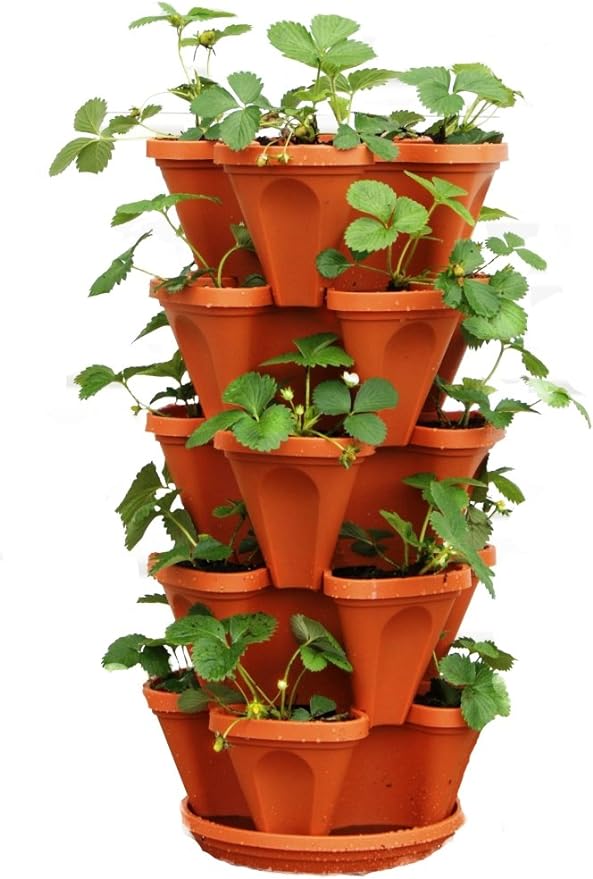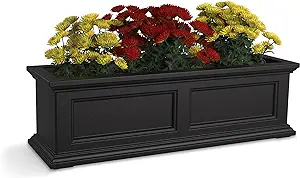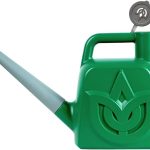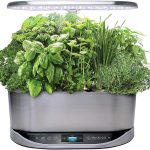You’ve probably experienced the frustration of watching your plants wither away due to poor watering habits. But what if you could enjoy the benefits of gardening without the hassle of daily watering? With self-watering planters, you can do just that. Imagine coming home to lush, thriving plants that have been watered to perfection, without lifting a finger. The good news is that there are plenty of innovative planters on the market that can make this a reality. But which ones are worth your investment? Let’s explore the top picks for low-maintenance gardening bliss.
Contents
- African Violet Pots for Indoor Outdoor Windowsill Gardens
- Click & Grow Indoor Herb Garden Kit
- Mr. Stacky TC-1 Planter, Terra Cotta
- Burpee Self-Watering Seed Starter Tray, 72 Cells
- Mayne Fairfield 3ft Window Box
- Window Garden Aquaphoric Self Watering Planter
- Factors to Consider When Choosing Self-Watering Planters
- Frequently Asked Questions
- Can I Use Self-Watering Planters for Succulents and Cacti?
- Are Self-Watering Planters Suitable for Indoor and Outdoor Use?
- Can I Customize the Water Reservoir Capacity in Self-Watering Planters?
- Do Self-Watering Planters Require Frequent Cleaning and Maintenance?
- Are Self-Watering Planters More Expensive Than Traditional Planters?
- Conclusion
African Violet Pots for Indoor Outdoor Windowsill Gardens
If you’re a busy bee with a green thumb, the African Violet Pots for Indoor Outdoor Windowsill Gardens are the perfect choice, offering a hassle-free way to keep your plants thriving while you’re on-the-go.
These self-watering planters are designed to make your life easier, preventing overwatering and underwatering with their special water injection port and cotton rope that absorbs water from the planter pot to keep the soil moist.
Made of sturdy polypropylene, these pots are durable and long-lasting, with a double-layer design for excess water storage and easy refill.
You can monitor the water level easily through the transparent material, and the mesh and liner included will keep your plants happy and healthy.
Best For: Busy people who want a hassle-free way to keep their plants thriving, especially those who tend to forget to water their plants regularly.
Pros:
- Time-saving and hassle-free, preventing overwatering and underwatering
- Allows plants to drink water only when needed, maintaining air circulation through the soil
- Suitable for indoor and outdoor plants, great for decorating various spaces
Cons:
- Some reviewers mentioned minor issues with the product design or shipping
- No specific warranty information is provided, although it’s available upon request
- The product is made in China, which may be a concern for some customers
Click & Grow Indoor Herb Garden Kit
With the Click & Grow Indoor Herb Garden Kit, you can effortlessly grow a variety of fresh herbs and vegetables indoors, thanks to its energy-efficient LED grow lights and easy-to-use design.
You’ll love how simple it’s to get started – just drop in the pre-seeded plant pods, fill the water reservoir, and plug it in.
The kit comes with over 50 plant pod options, including basil, cilantro, lavender, and chili peppers, so you can experiment with different flavors and scents.
Plus, once your herbs are grown, you can transplant them to outdoor or indoor planters.
With a compact design and high-quality grow light, this kit is perfect for indoor gardening, and its 4.6-star rating from over 2,260 customers speaks to its effectiveness.
Best For: Indoor gardeners, beginners, and those who want to grow their own herbs and vegetables year-round, especially during winter.
Pros:
- Easy to use and set up, even for those without a green thumb
- Fast-growing plants and a wide variety of pre-seeded plant pods to choose from
- High-quality grow light and compact design make it perfect for indoor gardening
Cons:
- May require additional care and fertilization to extend the life of pods and plants
- Refill pods can be expensive, although DIY options are available
- Limited space for planting, may not be suitable for large-scale gardening
Mr. Stacky TC-1 Planter, Terra Cotta
Growing strawberries, herbs, or succulents in a small space is made easy with the Mr. Stacky TC-1 Planter, Terra Cotta, which offers a unique 5-layer stackable design that protects against overwatering and root rot.
You’ll appreciate the flow-through design that prevents waterlogged soil, ensuring your plants receive just the right amount of moisture.
This versatile planter is made of durable, food-grade polypropylene and can be hung or free-standing, giving you flexibility in your garden setup.
With a capacity of 24 quarts, you can grow a variety of plants, from flowers to peppers, in a compact space.
The terra cotta color adds a touch of modern style to your indoor or outdoor garden.
Best For: Gardeners with limited space who want to grow multiple plants, such as strawberries, herbs, or succulents, in a compact and efficient way.
Pros:
- Easy to assemble and durable construction
- Versatile design allows for hanging or free-standing placement
- Flow-through design prevents overwatering and root rot
Cons:
- Some users have reported issues with watering and water distribution
- May require frequent watering due to the flow-through design
- Limited capacity of 24 quarts may not be suitable for large-scale gardening
Burpee Self-Watering Seed Starter Tray, 72 Cells
You’ll get the best results from the Burpee Self-Watering Seed Starter Tray, 72 Cells, if you’re looking for a thorough indoor seed starting system that minimizes overwatering and promotes healthier root development.
This all-inclusive set includes two 36-cell planting trays, two plant stands, a self-watering mat, a water reservoir tray, 72 super growing pellets, and a dome cover.
With space to grow up to 72 seedlings in cells measuring 1.5W x 1.5L x 2D each, you’ll have plenty of room to experiment with different herbs, flowers, or vegetables.
The entire tray measures 10W x 20L x 5H, making it a great option for indoor gardening.
Best For: Experienced gardeners and beginners looking for a comprehensive indoor seed starting system that promotes healthier root development and minimizes overwatering.
Pros:
- Complete indoor seed starting set with all necessary components, including self-watering system and growing pellets
- Spacious 72-cell tray allows for growing a variety of herbs, flowers, or vegetables
- Promotes healthier root development and minimizes overwatering for stronger seedlings
Cons:
- Some customers have reported issues with the self-watering system, including pellets expanding too much
- Large tray size can make transplanting seedlings difficult
- Requires careful handling and setup to ensure successful seed germination and growth
Mayne Fairfield 3ft Window Box
If you’re a busy gardener seeking a low-maintenance solution, the Mayne Fairfield 3ft Window Box is an excellent choice, thanks to its integrated water reservoir that reduces the need for frequent watering and promotes healthy plant growth.
This sturdy planter is made from 100% high-grade polyethylene resin with UV inhibitors, ensuring it won’t fade or discolor over time.
The powder-coated steel wall mount brackets make installation a breeze, and you can opt for decorative corbels or deck rail/handrail brackets if desired.
With a 6.5-gallon capacity and 36-inch width, this window box provides ample space for your plants to thrive.
Plus, its lightweight, weather-resistant design and 15-year limited warranty give you peace of mind.
Best For: Busy gardeners seeking a low-maintenance solution for their plants.
Pros:
- Sturdy and durable design made with 100% high-grade polyethylene resin with UV inhibitors
- Integrated water reservoir reduces the need for frequent watering and promotes healthy plant growth
- Easy installation with powder-coated steel wall mount brackets
Cons:
- No decorative corbels or deck rail/handrail brackets are included and must be purchased separately
- Limited to outdoor use only
- No assembly required, but may still require some effort to install
Window Garden Aquaphoric Self Watering Planter
Those who want a low-maintenance yet effective way to keep their plants healthy will appreciate the Window Garden Aquaphoric Self Watering Planter, which features a handy water level indicator and passive hydroponic action for ideal root zone oxygen and water balance.
You’ll love how this planter takes the guesswork out of watering, ensuring your plants receive the right amount of moisture.
The included 1-quart Fiber Soil and sleek, modern design make it a great addition to any indoor space.
With an impressive 4.5-star rating from over 800 customers, you can trust that this planter will keep your plants thriving.
Plus, the compact 5.25′ x 5.25′ x 5′ size and lightweight 11.3-ounce design make it easy to place on your windowsill.
Best For: Those who want a low-maintenance and effective way to keep their plants healthy, especially indoor herb growers and busy people who tend to forget to water their plants.
Pros:
- Foolproof self-watering system with a handy water level indicator, ensuring plants receive the right amount of moisture.
- Includes 1 quart of Fiber Soil and has a modern, sleek design that fits well in any indoor space.
- Compact and lightweight, making it easy to place on a windowsill, with an impressive 4.5-star rating from over 800 customers.
Cons:
- No specific warranty information is provided.
- The planter’s small size may not be suitable for larger plants or multiple plants.
- The product’s durability has not been tested over an extended period of time.
Factors to Consider When Choosing Self-Watering Planters
When selecting the perfect self-watering planter for your needs, you’ll want to think about a few key factors.
You’ll need to ponder the material and durability of the planter, as well as the capacity of its water reservoir.
Additionally, you’ll want to weigh the type of plant you’ll be using, the space you have available, and how easy the planter is to assemble.
Material and Durability
You’ll want to weigh the material and durability of a self-watering planter, as it directly impacts its longevity and performance.
When choosing a planter, look for materials that can withstand the elements and heavy use. Polypropylene is a popular choice due to its durability, resistance to corrosion, and ability to handle extreme temperatures.
High-quality plastics like polyethylene or polypropylene can last for years with minimal maintenance. The thickness of the material, measured in millimeters, is also a key indicator of durability, with thicker materials generally being more robust.
UV resistance is another essential factor, as it helps prevent fading and discoloration caused by prolonged sun exposure.
Additionally, the construction of the planter plays a significant role in its durability. Features like reinforced walls and sturdy bases contribute to its overall longevity.
By considering these factors, you’ll be able to find a self-watering planter that meets your needs and provides a healthy environment for your plants to thrive.
Water Reservoir Capacity
As you ponder the durability of your self-watering planter, it’s equally important to think about the water reservoir capacity, which directly impacts how often you’ll need to refill the planter.
A larger capacity means less frequent watering, while a smaller one requires more frequent refills.
When choosing a self-watering planter, you’ll want to bear in mind the water needs of your plant. If you have a plant that prefers more water, look for a planter with a larger capacity.
Conversely, if your plant likes dryer soil, a smaller capacity will suffice.
The size of your plant also plays a role – larger plants need more water, so a planter with a larger capacity is a better fit.
You must strike a balance between the water reservoir capacity and your plant’s watering needs to avoid overwatering or underwatering.
Plant Type Compatibility
Considering the unique needs of your plant is essential, since different species thrive in self-watering planters with varying capacities and features.
When choosing a self-watering planter, you need to think about the type of plant it will hold. For instance, plants with smaller root systems, such as herbs and succulents, do well in planters with shallower water reservoirs. On the other hand, plants with larger root systems, like tomatoes, require deeper reservoirs.
Some plants aren’t suitable for self-watering planters at all. For example, plants that prefer well-draining soil, such as cacti and orchids, can be prone to overwatering in these planters. On the other hand, plants like ferns and peace lilies, which prefer high humidity, may benefit from self-watering planters with built-in water indicators to verify the soil is consistently moist.
It’s vital to research the specific watering needs of the plant you intend to use in a self-watering planter. This makes certain the planter can accommodate its requirements. By taking into account the unique needs of your plant, you can choose a self-watering planter that provides the right amount of water and care for your plant to thrive.
Space and Portability
When selecting a self-watering planter, you must consider the importance of space and portability, since the planter’s size, weight, and material will greatly impact its usability and the overall health of your plant.
Measure the available space where the planter will be placed to confirm the planter’s dimensions fit comfortably, leaving enough room for maintenance and viewing.
If you plan to move the planter frequently, look for lightweight and durable materials, such as polypropylene or resin, that can withstand regular handling.
Consider the planter’s design and features, such as built-in handles or a compact shape, that can make it easier to move and relocate.
Assess the planter’s capacity and water reservoir size to verify it can support the plant’s growth and water needs, even when moved to a new location.
Ease of Assembly
You’ll save time and frustration by opting for self-watering planters that boast easy, tool-free assembly, allowing you to get your plants settled in quickly and effortlessly.
When choosing a planter, look for ones with snap-together or tool-free assembly to minimize setup time and effort.
Before making a purchase, check the product description or manufacturer’s website for assembly instructions or videos to gauge the complexity of the process.
You’ll also want to verify planters with fewer pieces or components to reduce the risk of lost or missing parts.
Opt for planters with clear and concise instructions or diagrams to facilitate a smooth assembly process.
If you’re not comfortable with DIY assembly, select planters that come pre-assembled or offer professional assembly services.
Maintenance Requirements
As you choose a self-watering planter, remember that it’s vital to think about the ongoing upkeep requirements to guarantee your plants thrive.
While these planters reduce the frequency of watering, they still need regular checks to verify the water reservoir isn’t empty and the soil isn’t waterlogged.
You’ll also need to occasionally clean the water reservoir and wicking system to prevent clogging and maintain peak performance.
Additionally, your plants will still require occasional fertilization, pruning, and pest management to maintain their health and appearance.
Be aware that overwatering can still occur if the soil mix isn’t well-draining or if the plants aren’t suited to the planter’s watering system.
To avoid this, follow the manufacturer’s instructions for maintenance and upkeep.
By doing so, you’ll guarantee your self-watering planter functions correctly, and your plants will flourish.
Frequently Asked Questions
Can I Use Self-Watering Planters for Succulents and Cacti?
You’re wondering if self-watering planters are suitable for succulents and cacti. Yes, you can use them, but be cautious not to overwater, as these plants prefer dry soil; adjust the watering schedule accordingly.
Are Self-Watering Planters Suitable for Indoor and Outdoor Use?
You’re wondering if self-watering planters are suitable for indoor and outdoor use. Yes, they are! Most planters are versatile and can thrive in both environments with proper care, but make certain you choose a planter designed for your specific climate and lighting conditions.
Can I Customize the Water Reservoir Capacity in Self-Watering Planters?
You can customize the water reservoir capacity in some self-watering planters by adjusting the size of the water tank or using an extension kit, but it depends on the planter’s design and brand.
Do Self-Watering Planters Require Frequent Cleaning and Maintenance?
You’ll be relieved to know that self-watering planters typically don’t require frequent cleaning, but you’ll still need to occasionally rinse the water reservoir and check for clogs to promote peak performance.
Are Self-Watering Planters More Expensive Than Traditional Planters?
You’ll find that self-watering planters can be pricier than traditional ones, but you’re paying for the convenience of reduced watering frequency and lower maintenance, which may be worth the extra cost for you.
Conclusion
As you’ve explored the 6 best self-watering planters, remember that ‘an ounce of prevention is worth a pound of cure.’
With these innovative planters, you’ll prevent common gardening pitfalls and enjoy lush, thriving plants with minimal effort.
Say goodbye to overwatering and underwatering woes, and hello to a stress-free gardening experience.
With the right self-watering planter, you’ll be on your way to a beautiful, low-maintenance garden that brings joy and serenity to your life.











